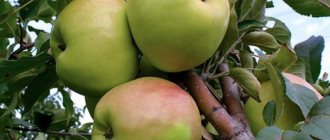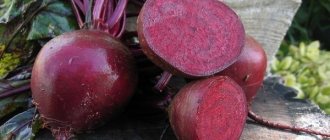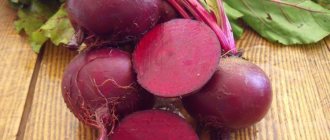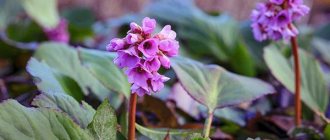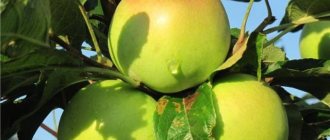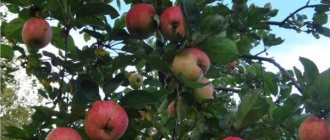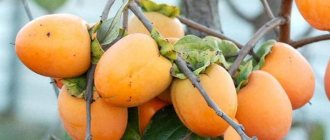One of the main vegetable crops, without which it is impossible to prepare many dishes, is beets. Everyone knows about its beneficial properties. Russians fervently believe that she is the “indigenous inhabitant” of all garden plots. But no matter how strange it may seem, beets were brought from Byzantium. In Rus' they became acquainted with it only in the tenth century. This is a fairly hardy crop, growing everywhere in the country, not excluding Siberia. Bordeaux beets feel great in the middle zone.
Description of Bordeaux beet varieties
In 1937, domestic breeders managed to develop burgundy beets for cultivation in the southern regions. Now it is presented in two varieties:
- Bordeaux 237. An original variety of vegetable. It was included in the State Register of Breeding Achievements of the Russian Federation in 1943 at the request of the Federal Scientific Center for Vegetable Growing.
- Bordeaux single seed . It is a “descendant” of the previous variety and was bred by breeders in 2003. The main difference between them is that single-seeded crops do not require primary thinning, since only one sprout is produced from each seed.
The characteristics of the two Bordeaux beet varieties can be found in the table:
| Parameter | Description |
| Ripening time | Bordeaux 237 is a mid-early variety that ripens within 80-95 days in warm conditions, and within 110-115 days in cool conditions. Single-seeded Bordeaux is an earlier ripening version, so the growing season before harvest is on average 60-65 days. |
| Cultivation regions | This variety of beet is heat-resistant, so it grows well in fields and gardens during the hot, long summer season. In this regard, it is better to cultivate it in warm regions of Russia, Ukraine, Belarus, Moldova and other CIS countries. Meanwhile, a good harvest can also be obtained in the central zone of the Russian Federation, where the climate is temperate continental. In such conditions, Bordeaux will withstand short droughts, colds and temperature changes. |
| Leaf rosette | The plant grows in a dense bush with dark pink or burgundy long petioles. The leaf rosette is semi-erect and medium in size, but at the same time looks compact. The leaves themselves are wide, oval and with wavy edges. They reach 35-40 cm in length. The leaf blade has a glossy and slightly bubbly surface, a dark green color, diluted with pronounced red veins, colored by anthocyanins. The leaves of the plant are suitable for consumption. They can be collected as they grow. Young greens have the best taste. |
| Roots | Bordeaux 237 bears fruit with large root crops weighing on average 250-500 g, but single-seeded Bordeaux will delight you with smaller heads weighing up to 150-230 g. Otherwise, these varieties have no differences and their root crops with thin, few roots can be recognized by the following parameters:
The smallest root vegetables, which form in mid- and late July, are also suitable for consumption. They can be used to prepare any dishes and boiled. Boiled beets not only retain their rich color, but also the pleasant juiciness of the pulp. |
| Seeds | Beet seeds are large (2-4 mm), polyhedron shaped and dark brown in color. They are enclosed in a dry box, and their surface is covered with caverns. You can prepare the seeds yourself or purchase them at a garden store. As a standard, planting material cannot be stored for longer than 2 years. |
| Productivity | The amount of harvest depends on specific weather conditions. Cold, wet summers with low temperatures will slow down the formation of root crops. On average from 1 sq. m of bed, it is possible to obtain from 4 to 8 kg of root crops buried half into the ground. When grown on an industrial scale, the yield ranges from 70 to 90 tons per 1 ha. A distinctive feature of this beet is that in the southern regions it is capable of producing crops several times a year. |
| Keeping quality | Thanks to their thick skin, root vegetables can be stored for 6 months or more. They can be transported without the risk of loss of commercial quality. |
| Disease resistance | Bordeaux beets have weak resistance to peronospora and cercospora. |
Variety varieties
The Bordeaux variety has two varieties: Bordeaux 237 and single-seeded Bordeaux. The only difference between them is that after germination, single-seeded beets do not need to be thinned, since only one sprout sprouts from each seed.
Bordeaux 237, in turn, became the progenitor of the Incomparable A-463 and Podzimnyaya A-474.
The incomparable variety has a delicate taste and rapid ripening (70 days).
Podwinter can be sown in late autumn for an early harvest. It is also color resistant.
Sowing time
When sowing seeds directly into open ground, work can be carried out at different times of the year:
- In the spring . To get an early harvest, in the southern regions sowing can be done from mid to late April, when the soil warms up to +9-10°C during the daytime. The optimal air temperature is not lower than +5°C. With such sowing, the root crops will be suitable for harvesting in July. If the vegetable is planned for long-term storage, it is better to sow the seeds at the end of May. You can get ripe beets in August.
- In summer . For better preservation of root crops, seeds can be sown in June. They will be harvested in the fall.
- In autumn (pre-winter sowing) . Bordeaux beets can be sown before winter to get an early harvest, although ripened root crops will not have good shelf life. The best time for sowing is in October or early November before frost and at a soil temperature of at least -5°C. This planting needs to be mulched with pine needles and sawdust.
The best temperature for active growth of beets is +22°C, although seedlings can withstand short-term temperature drops to -2°C. In case of prolonged cold weather, they will stop growing and die.
In addition to direct sowing in the ground, Bordeaux beets can be cultivated by seedlings. It will allow you to get an earlier harvest, although the root crops will not be unsuitable for storage until the next season.
In a greenhouse, seeds can be sown for seedlings in mid-March, and in greenhouses - in late March or early April. In May, when the soil warms up to +10°C, the sprouts can be transplanted to a permanent location.
Compare beet varieties and choose the best
Let's look at several varieties of this crop to understand which one is better.
“Smuglyanka” is a fairly productive variety that can grow under any conditions. The beet pulp is pleasant to the taste, the root itself is round in shape. Such crops are well transported and perfectly preserved.
“Mulatto” is a mid-early variety, approximately 120 to 130 days pass before it is time to harvest. The weight is significantly inferior to Bordeaux - 120-360 grams. It stores well, the fruits are smooth, round in shape, and the color is quite red.
“Cylinder” has the same early ripening period as “Bordeaux”. The root vegetables are shaped like a cylinder, weigh about five hundred grams, they are juicy and sweet, and store well. It differs from Bordeaux in that this variety requires light soil for good germination. Prone to color.
“Egyptian flat” - this beet has an unusual shape - it is flattened and round. It ripens later than the heroine of this article, with a difference of about a week and a half. This variety does not have a tendency to shoot, but it is stored much worse, “not surviving” until next year’s harvest.
“Detroit” is a variety familiar to many gardeners; its characteristics are similar to “Bordeaux”. The main difference is the weight of the fruit - 100-200 grams. For this beet to ripen, it only takes three months (three and a half weeks less than Bordeaux).
Comparing the color scheme, we can say with confidence that the heroine of this article has the most saturated color. In addition, the brightness remains the same both during cooking and during preservation. Based on the reviews, one can judge that the examples given are similar in some ways and different in others. Some people like one variety, some people like another. Therefore, before making a final choice, you can try several, and then decide.
Site selection and soil preparation
Bordeaux beets are demanding in terms of where they are grown, so when choosing one, you should definitely consider the following rules:
- The sowing area should be well lit and warmed by sunlight, since half of the vegetable when ripened is above the surface of the ground and needs warmth in order to actively develop and gain sugar content. Shading and drafts are unacceptable.
- A deep groundwater table is desirable.
- Vegetables can be grown in the same place for no more than 4 seasons in a row. It cannot be planted after other varieties of beets and cabbage, but good predecessors are: potatoes;
- tomatoes;
- cucumbers
An area with suitable parameters must be prepared for beets in advance, following these instructions:
- In the fall, spread humus from cow manure or last year's compost over the surface of the plot. You can also water it with a solution of bird droppings (1:20) and add wood ash at the rate of 3 cups per 1 sq. m. m. Nitrogen fertilizers need to be applied only in small quantities, since beet roots tend to accumulate nitrates. After adding them, dig up the area using the bayonet of a shovel.
- In spring, apply complex mineral fertilizers. Beets are most responsive to potassium chloride and superphosphate. If you need to reduce the acidity of the soil, also add dolomite flour.
- After digging, form high or medium height beds on the site. Experienced vegetable growers also grow Bordeaux beets in ridges formed from soil.
Agricultural practices
The seeds of this crop are sown in the fresh air from April to June. The width between the rows should be forty-five centimeters. Two-line sowing can also be used. In this option, there will be the same 45 cm between the rows, and 20 cm from one belt to the other. In the same way, it is permissible to carry out a three-line version of sowing seeds.
Beetroot is sown in parallel with the early grain crop. To begin with, apply a five-centimeter cultivation. According to the seeding rate, the following proportions are established: 10 grams of seeds are enough for ten square meters, or from seven to ten kilograms for 1 hectare.
If all this is to be realized in the southern lands, the quantity of seeds should be increased to sixteen kilograms per hectare. The embedment depth is three centimeters. The land plot must be harrowed in two tracks.
It is necessary to prepare the soil in advance, so for ten squares of land you need 750 g of superphosphate, 600 g of ammonium nitrate and 630 g of potassium salt. These beets are intended for processing only.
Before we talk about growing Bordeaux 237 beets, we should briefly mention what they are. This is a mid-early variety, in which technical ripeness of the fruit occurs approximately on the 95th -110th day from full germination. The root vegetables themselves are round, weigh up to half a kilogram, the flesh is dark red, and very tasty.
You may be interested in:
This beet will take root on absolutely any land. What is important is how to harvest the root crop. If the soil is light, then it is better to simply pull out the beets by hand, but if it is moist or heavy, then you can carefully use a shovel or fork.
As an undemanding crop, Bordeaux 237 is capable of producing the greatest yield only if favorable conditions are created for it. Even if it grows on dense soil, if it is provided with good permeability, the probability of good yield of root crops will be quite high. Sand, organic matter and peat should be added to heavy soil. If the sandy soil is compacted, humus, soil and compost are used.
If the soil where you plan to grow beets is depleted, then in the autumn months you need to “treat” it with double superphosphate (40 g per 1 m2) and potassium salt (60 g per 1 m2). But with the onset of spring, it is customary to fill the soil with ammonium nitrate: 30 g of fertilizer is applied per square meter.
If the soil is acidified, lime is useful - 500 g per square meter. It is necessary to carry out liming twice: in autumn and early spring.
The best soil that can be offered for growing beets is neutral loam.
Bordeaux 237 beet seeds should be planted in long furrows, and the distance between them should be half a meter. If you plan to make rows across the beds, then this distance should be thirty centimeters. When sowing in light soil, the seeds should be deepened by 4 cm, and in heavy soil by 2 cm.
It is best to sow beets when onions, cucumbers or nightshade crops previously grew in the bed that is intended specifically for them, and it is bad if cabbage is used.
Sowing is carried out in mid-April, at a temperature of 5 °C. The soil should be loose, fertile, with a deep arable layer. You should pay attention to the acidity of the soil - it should be neutral. Otherwise, the root vegetables will be small and fibrous. In June, you can sow the seeds again to get an autumn harvest of beets, which will have excellent shelf life.
The planting pattern can be row, with row spacing of 45 cm, two-line strip - 50-20 cm, on unclogged soils - three-line strip with intervals of 50-15-15 cm. Seed placement depth is about 3 cm. Recommended seed consumption Bordeaux 237: 7 - 10 grams per 1 square meter. Pre-winter sowing is carried out in October, before the onset of frost.
During the growing season, it is necessary to loosen the row spacing, weed and thin out the seedlings. Watering - as needed, the variety does not like waterlogged soil. It prefers potassium complexes among fertilizers, and is especially responsive to the addition of ash.
Harvesting is very easy, since root crops that have reached technical ripeness rise almost half above the ground.
Bordeaux 237 is an unpretentious and productive beet. The excellent taste of the pulp, which also contains a large amount of vitamins and nutrients, makes the vegetable a valuable food product. The harvested crop is perfectly stored. Among the disadvantages, we can note the demandingness of soils and instability to peronospora and cercospora.
When cultivating Bordeaux 237 beets on farms, it is recommended to fulfill certain requirements, which are listed below.
- In open ground, seeds are sown from April to June, in a row with a row spacing of 45 cm. Two-line sowing is also used, in which the distance between the rows remains the same as in the first case, and 20 cm is left between the tapes. In the same way, you can produce and the three-line sowing method.
- Beetroot is sown simultaneously with early cereal crops. Pre-cultivation is carried out at a depth of 5 cm. Seed sowing rate: per 10 m2 - 10 g, or per 1 ha - 7-10 kg. In the southern regions, the number of seeds is increased to 16 kg per 1 ha. The depth of embedding is 3 cm. The ground is harrowed in two tracks.
- Preliminary soil preparation: 600 g of ammonium nitrate, 630 g of potassium salt and 750 g of superphosphate are added per 10 square meters.
This variety is intended for processing and is not used for fodder.
Processing of planting material
Before sowing, the seeds must be subjected to the following treatment:
- Sort, leaving equally large copies.
- Soak in a weak solution of manganese for a few minutes to disinfect and rinse under running water. To increase resistance to cercospora, the seeds should also be treated with Agat-25K. Disinfection with Apron disinfectant will protect future plantings from downy mildew.
- To stimulate growth, immerse the seeds in warm water for 12-24 hours, to which you first add a pinch of soda and 1 tsp. ash, boric acid and superphosphate.
Before sowing, some gardeners also germinate beet seeds, but this measure is more justified if they are sown as seedlings, as it will help them to hatch faster.
Landing region
Vegetables grow well in fields and gardens in hot, long summers. Bordeaux is a heat-resistant beet.
With the development of the seed trade, this vegetable also appeared in colder regions - in the Russian non-black earth region, in Siberia, and in the Far East. The main condition for successful cultivation is the presence of dry, warm weather and the absence of prolonged rains.
Beetroot of this variety is sometimes grown in large greenhouses. Greenhouse conditions make it possible to obtain an early, higher harvest than in open fields.
In greenhouses, beet seeds are planted for seedlings. The sprouts are picked when four to five leaves appear. The development of greenhouses has made it possible to significantly expand the growing area for Bordeaux beets.
Sowing seeds in the ground
When the optimal time arrives, you need to start sowing seeds, following these instructions:
- Dig furrows in the ground 3-4 cm deep at a distance of 6-8 cm. If you plan to sow in rows, keep about 25-30 between them so as not to thicken the planting and provide each bush with the proper amount of light.
- Pour humus into the prepared furrows to feed root crops and ash to reduce the acidity of the soil. Such manipulations can be skipped if the beds are well prepared.
- Sow the seeds, sprinkle them with 3-4 cm of soil and water them with water from a watering can. Their optimal consumption is 7-10 g per 1 square meter. m.
Experienced gardeners prefer to sow Bordeaux along the edges of the beds, which allows for more economical use of space on the site. Good neighbors for beets will be:
- tomatoes;
- cucumbers;
- garlic;
- salad;
- radish.
These crops do not oppress each other, so their productivity will be at the highest level.
Advantages of the variety
Svela Bordeaux is universally loved by gardeners. It is famous for its stable yield, resistance to heat and drought, and is perfectly stored until spring.
Bright, neat root vegetables are distinguished by their juiciness and sweetish taste. The fruits are not too large, so they are convenient to bake and use in salads.
Bordeaux has practically no disadvantages.
The Bordeaux beet variety is very popular and has found its use among many amateur gardeners. The following differences are listed below:
- mid-season;
- has high commercial qualities;
- resistant to diseases, with the exception of cercospora and peronospora;
- tolerant to high temperatures and drought;
- has good taste;
- has a high degree of keeping quality.
The variety is intended for growing crops in the southern regions of the country, but adapts well to the northern regions. And due to the short ripening period of root crops, beet seeds can be sown in two stages and get double returns.
We invite you to familiarize yourself with Types and varieties of quince: ordinary, oblong, garden, ornamental, pear-shaped, Chinese and Japanese quince
Features of planting through seedlings
If you decide to cultivate beets using the seedling method, first of all, you need to grow strong seedlings, which can be done in a snail or ordinary containers with a nutrient soil mixture. During the seedling period, it is advisable to treat the crop with the fungicide Rovral Aquaflo to prevent cercospora.
After 4-5 weeks, when the seedlings have become stronger and have acquired several true leaves, they can be transplanted with a clod of earth into grooves prepared in advance according to the above scheme. You need to act carefully so as not to damage their delicate roots, otherwise this will negatively affect the formation of root crops.
The first time of planting it is worth shading so that they quickly adapt to new conditions. In cold weather, you need to cover the seedlings with spunbond.
Some subtleties of mid-season varieties
As a rule, mid-early root vegetables have excellent taste and do not take long to harvest. But since the seedling method is more commonly used when growing Bordeaux 237 beets, inexperienced gardeners may encounter some difficulties.
We invite you to familiarize yourself with Outdoor ovens and barbecues made of bricks
If, during transplantation, the root is damaged even slightly, an additional root will form in the exposed area. There is a possibility that instead of a beautiful round head, you can get an ugly root crop of several fruits. However, if the gardener does not want to fuss with the roots, then it is better to plant beets with seeds.
When transplanting seedlings, the main thing is not to damage the core, which extends from the center of the fruit and is located inside the green mass. The side leaves should be cut off and the plant should be watered well during the first days.
Planting care
Under no circumstances should beets be hilled, as this will prevent the root crops from receiving the required amount of solar heat. However, there are a number of agrotechnical measures that are mandatory.
Watering
Bordeaux beets love moisture, so you need to organize proper watering of the crop according to the following scheme:
- Water abundantly at the beginning of the growing season using the sprinkling method, drip irrigation or root saturation with moisture. This activity can be performed 1-2 times a week in dry and hot weather. On rainy days, it is better to hold off on watering.
- During particularly dry periods, water the row daily or once every two days to prevent the soil from drying out, otherwise this will cause the death of germinating seeds or cracking of root crops.
- From the moment the heads form, reduce the frequency of watering to once every 10-14 days.
- At the beginning and end of summer, water the beets with a saline solution so that the root vegetables are sweet and can be stored until the next season. To prepare it, just dilute 30 g of table salt in 10 liters of water. If possible, you can also use sodium nitrate (50 g per 10 liters of water).
- 3-4 weeks before the expected harvest, completely interrupt watering the crop, otherwise the fruits will turn out watery.
Thinning
When planting beets with seeds in the ground, you need to regularly thin out the strong shoots. It is best to do this during the fruit setting phase. Weak plants need to be removed, and strong bushes should be left in the beds, maintaining equal intervals between them of at least 15-25 cm in length.
Soil treatment
After watering or rain, the bed must be carefully loosened with a pitchfork to provide the root crops with a sufficient amount of oxygen. At the same time, you need to weed out the weeds, otherwise they will suck too many nutrients from the soil to the detriment of the beets.
Feeding
If you properly feed the crop, then by the end of the growing season you can get large root crops with dense, juicy and moderately sweet pulp. Here is the optimal feeding scheme:
- 2 weeks after sowing, water the seedlings with herbal infusion, which is best prepared in the spring, when young, juicy grass blooms - nettle, sweet clover, dandelion, etc. The infusion should be prepared as follows:
- fill a bathtub or other container a third with young mowed grass;
add 5 liters of ash, 1 pack of Persian yeast and 1-1.5 liters of whey;
- pour water into the container to the brim and mix thoroughly;
- leave the mixture for 2-3 weeks (when the nettle and sweet clover dissolve, the composition will be ready).
- At the initial stage of development, feed the plant with nitrogen fertilizers. The best option is mullein diluted with water in a ratio of 1:10. You should not overdo it with such fertilizer, otherwise a shock dose of nitrogen will contribute to the rapid development of tops to the detriment of root crops.
- When the leaves begin to close together, feed the beets with calcium nitrate and phosphorus. Also sprinkle ash on the garden bed (1/2 cup per 1 sq. m) and embed it in the soil.
- In August, pour ash infusion over the beets, to prepare which, soak 1 kg of ash in 10 liters of water for a day.
The resulting infusion can be watered on beets 3 times a season, but always in a diluted form - at a rate of 1:10 for sprinkling and 1:3 for root feeding.
Protection from diseases and pests
Bordeaux beet varieties are resistant to many diseases, but the following pathologies pose a danger to them:
- Phimosis (heart-shaped rot) . A fungal disease that is dangerous for root crops during winter storage. It appears as black spots on the tail and upper parts of the heads. Velvety white rot can be seen inside such formations. To prevent phimosis from destroying the entire crop, beets should not be planted in alkaline soils. If signs of disease are found, the affected specimens must be discarded and destroyed, otherwise the fungus will spread to healthy root crops.
- Cercospora blight . The fungus infects beet tops, which become covered with necrotic spots with a red or brown border. Brown blotches are visible on the trunks. The disease develops actively in wet weather conditions. As a result, it causes the death of all tops and prevents the growth of root crops. Cercospora blight cannot be cured, so all diseased plants will have to be destroyed.
- Downy mildew (downy mildew) . It attacks the leaves and flower stalks of the plant, causing the formation of a gray-violet coating on the tops. Gradually, the leaves become pale and fragile, curling towards the ground. Then they turn black and die. At the same time, the above-ground part of the plant rots, and the fruits become smaller, lose their sugar content and become prone to rotting during storage. Downy mildew cannot be cured, so diseased plants will need to be destroyed.
To prevent the development of these diseases, it is necessary to observe crop rotation and disinfect the soil and seeds.
Among the pests, only beet insect pests can affect the garden bed, the main ones being:
- Cicadas . To combat them, the above-ground part of the plant must be treated with contact and systemic insecticides.
- Leaf beetle . Affected leaves should be torn off and destroyed away from the garden bed.
- Aphids (leaf, root) . The drugs Rotenone and Malathion will help with it.
How to grow
Let's look at the features of growing beets.
Planting with seeds/seedlings
Beetroot, compared to other vegetables, has fairly large seeds; they are planted in a prepared furrow at a distance of up to 5 cm from each other.
You can sow seeds either dry or pre-soaked in a solution with a growth stimulator.
To grow seedlings, seeds are sown in boxes in April. The result is that the crop ripens almost 20 days earlier than those planted directly in the ground. When the sprouts have 2-3 true leaves, the seedlings can be planted. This happens around mid-May, when the soil warms up to +10 °C.
The Bordeaux 237 variety can be planted before winter: the seeds are sown in the ground before the onset of cold weather and mulched. In this case, the harvest will be early. But such beets are not stored for a long time.
Care
In order for root crops to grow large and juicy, they need to be watered. Young beets are watered in the evening once a week, and the next morning the soil around the seedlings is loosened to avoid the formation of an earthen crust. Mature plants are watered less frequently.
To make maintenance easier, many gardeners mulch the soil around their plantings. This avoids frequent loosening and watering.
Young sprouts need regular weeding, otherwise the weeds will take away nutrients and can also cause various diseases.
Regular feeding is extremely important for the full development of root crops. At the beginning of the season, nitrogen is added to plants for growth, and later phosphorus, potassium, and boron are added to form fruits.
Reference! Beets also respond gratefully to foliar feeding.
If the soil on your site is poor, then it needs to be fertilized to replenish nutrients. However, an excess of minerals can negatively affect the quality of root crops: they will crack and voids will form inside.
In addition, beets tend to accumulate nitrates, which are harmful to human health. When fertilizing with fertilizers, it is important not to exceed the dosage. Towards the end of the season, watering and fertilizing are stopped.
Features of cultivation and possible difficulties
Caring for beets is a simple matter. However, there are also secrets here.
- Beets love a sunny place.
- You cannot plant root crops where cruciferous vegetables grew.
- The best predecessors in the garden are tomatoes, onions, garlic, and eggplants.
- Beets love light, alkaline soils.
- Experienced gardeners make a beet border along cabbage and carrot plantings. These vegetables have similar agricultural technology, so it will be convenient to grow them side by side.
- Despite the moisture-loving nature, beets do not like stagnation of water at the roots. If there is an excess, the roots begin to rot. Therefore, you need to take care of good drainage.
- Beets need space to form full-fledged root crops. Therefore, do not plant plants close to each other.
Diseases and pests
The Bordeaux variety is resistant to diseases and pests. But if signs of phomosis, peronsporosis or powdery mildew appear on the plant, begin treatment immediately.
Various insects also love to feast on juicy beet leaves. Folk remedies are effective in controlling pests: infusion of onion peels and wood ash.
Harvest and storage
Harvesting root crops at the scheduled time will not cause any special problems, since the root crops are partially above the ground and can be easily pulled out of it if you first dig them up with a shovel.
Beets can be stored for 5-6 months without loss of consumer qualities if kept at a temperature of -1...+2°C. At higher temperatures, the vegetable will actively waste moisture, causing it to become flabby.
The optimal storage location is a cellar, where root vegetables can be kept in boxes with damp sand or in baskets on the floor. They can first be mixed with potato tubers.
A small amount of beets can be stored in the refrigerator for a long time, placed in the vegetable compartment.
Growing Bordeaux 237 beets on a personal plot
Beets take root in any soil, even heavy soil. But there is a point that you should pay attention to when harvesting beets. On structured, light soil, beets are pulled out by hand to reduce trauma to the root crops. On heavy and moistened ones, dig in lightly with a shovel or pitchfork.
Like any unpretentious crop, Bordeaux beets will give maximum yield if optimal conditions are created for them. Despite the fact that it grows in dense soil, if you create good permeability, the yield of root crops will become richer. Heavy soil is structured with organic matter, peat and sand.
To compact sandy soil, use turf soil, compost and humus.
If the soil is depleted, then double superphosphate (40 g per 1 m2) and potassium salt (60 g per 1 m2) should be added in the fall. In spring, the soil is enriched with ammonium nitrate, 30 g of fertilizer is added per 1 m2.
Lime is added to the acidified soil - 500 g per 1 m2. Two stages of liming are carried out - in autumn and early spring.
Neutral loamy soil is the best option for growing beets.
Bordeaux seeds are recommended to be sown in places where nightshade crops, onions and cucumbers previously grew. An undesirable precursor for beets is cabbage.
The seeds are sown in longitudinal grooves, the distance between which is 0.5 m. If the rows are prepared across the bed, then 30 cm are left between the rows. On heavy soils, the seeds are deepened by 2 cm, on light soils by 4 cm.
Pros and cons of Bordeaux beets
The strengths of burgundy beets are as follows:
- good product and taste qualities;
- the ability to store for a long time without loss of taste, density and aroma;
- resistance to long-distance transportation;
- resistance to dry and hot weather;
- high yield and almost 100% germination.
As for the shortcomings, gardeners often note the following:
- unplanned picking of Bordeaux 237, since sometimes 2-3 sprouts are formed from one seed;
- the need for a large growing area in order to maintain sufficient gaps between plants and allow the root crops to grow to the size stated by the manufacturer.
Characteristics
The dark red, round fruits are 12-15 cm in diameter. Sometimes the root crop has a peculiar shape, typical for beets - slightly flattened at the aerial part. As it develops in the soil, almost half of its mass comes to the surface. The pulp of Bordeaux beets has a rich color, with barely noticeable ringing. Fruit weight is up to 500 g. Root crops reach technical maturity 100 days from the moment of sowing the seeds.
You can add the following information to the variety description. This root crop responds well to the application of ash and various potash fertilizers. During the growing season, it is necessary to loosen the row spacing, weed and thin out the seedlings. Watering should be carried out based on weather conditions, because beets do not like waterlogging.
If we mention ripening, then this variety is mid-early. Quite sweet in taste. We can say that such beets are unpretentious - just like beets of other varieties, they love sunlight, air, water, and organic feeding.
If you harvest it in the fall, you can eat it until the end of spring or even the beginning of summer next year. The presentation and taste remain the same.
If agrotechnical work is carried out correctly, then from one square meter you can harvest about eight kilograms of beets, while the consumption of seed material will be one or two grams for such an area. On a large scale, up to eighty tons are collected from one hectare.
- The variety belongs to the mid-early variety - the period from germination to the onset of technical ripeness ranges from 62 days in warm regions and up to 116 days in cool regions;
- yield - 4 - 8 kg per square meter;
- a distinctive feature is heat resistance, so beets tolerate elevated temperatures and periods of drought;
- also adapts well to cool climates with characteristic temperature fluctuations;
- Bordeaux 237 has good resistance to many diseases, but may not resist downy mildew and cercospora;
- ripe vegetables do not crack;
- The shelf life is excellent; it can be stored all winter without loss of taste and commercial qualities. The grated pulp can be frozen or dried;
- refers to table varieties, universal use. It is used fresh in vitamin salads, is an indispensable ingredient for borscht, and is suitable for stewing and pickling. By the way, the tops of young beets are also used for food. It is suitable for vitamin soups and salads.
The variety has a “descendant” - a single-seeded variety of Bordeaux. It ripens a little later and is a little smaller in size - up to 400 grams. The name is due to the fact that this crop is a single-growth crop that does not require thinning.
Reviews about the variety
★★★★★
Dmitry, 29 years old. Among all beet varieties, Bordeaux has long been cultivated.
It germinates well and produces round root crops. We immediately eat the largest of them, and store the rest, if possible, for storage. This beet makes excellent borscht and other “red” warm dishes, since it does not lose its color during heat treatment. I recommend to everyone! ★★★★★
Elina Vasilievna, 48 years old. My family prefers large beets, so we traditionally grow Bordeaux varieties.
The flesh is dark red with a good taste, although I can’t say that it is significantly better than other varieties. The variety withstands hot summers and does not dry out, which is extremely important for me as a resident of the southern region. In addition, beets are not late, so you don’t have to wait long to taste the fresh vegetable. ★★★★★
Natalya Yurievna, 51 years old. This year I was very pleased with the amount of harvest - from 4 small beds I collected 10 kg of neat root vegetables weighing up to 500 g. To achieve such results, I advise you to thin out the plants correctly, leaving about 20 cm between them.
Hide
Add your review
In the next video, the gardener will show his bed of Bordeaux beets and tell you how to properly cultivate them to obtain large, fleshy root crops:
Bordeaux beets are tall bushy crops bearing large root crops. Varieties of this type are resistant to heat and undemanding in care, so they are favorites among many gardeners. Root vegetables can be widely used in cooking or subjected to long-term storage in the cellar until the next season.
0
0
Copy link
Farmer reviews
We bring to your attention reviews from summer residents who have already cultivated the Bordeaux variety and its varieties.
Olga, 57 years old, Rostov region: “ Our family loves beets. We plant a lot and have tried different varieties. But Bordeaux is beyond competition. Always a big and tasty harvest. We even tear the tops into salad and cold borscht.”
Alexey Ivanovich, Chelyabinsk: “I plant Bordeaux beets every year. It's very tasty. And it keeps well. Of course, I weed and water. But I didn’t notice that it grew worse in dry summers. We always collect a lot. I tried to grow and prepare the seeds myself, but it didn’t work. A lot of hassle. It’s easier to buy ready-made ones; there are a lot of them now and they’re inexpensive.”
Alexander, Moscow region: “We have been planting beets at our dacha for several years now. And recently we settled on Bordeaux. There is practically no maintenance, the main thing is to water it on time. But borscht made from its own beets is delicious! Both bright and tasty. We also like to chew beets even raw: we cut them into slices and crunch them.”
Growing instructions
Buying seeds
There are two types of seeds on sale: “Bordeaux 237” and “Bordeaux single-seeded beetroot”. The second variety has a lighter root weight (150-230 grams). Seeds can be purchased all year round in specialized stores for gardeners and in chain stores during the planting period.
Depending on the manufacturer, the price ranges from 12 to 50 rubles per sachet. Pack weight 3-5 grams, contents 40–50 pieces. Often there is garbage inside.
When to plant?
You can start planting beets at the end of April or in the winter method in the second half of October, before the first frost, so that the seeds do not die. Before winter, it is good to add humus to the soil, and in spring mineral fertilizer.
Selecting a location
Bordeaux is planted only in sunny areas; even slight shading can significantly reduce the yield. The root crop grows well in places where potatoes, cucumbers, tomatoes, and onions previously grew.
The soil
It is important to pay attention to soil acidity indicators. This variety requires neutral or slightly acidic soils for good growth. Even with a slight increase in acidity, the root vegetables become very small and become fibrous and tough.
Even with a slight increase in acidity, the root vegetables become very small and become fibrous and tough.
When there is an excess of alkali in the soil, fungal rot appears on the roots and leaves. Neutral loamy soil is the best option for growing beets
Even with a slight increase in acidity, the root vegetables become very small and become fibrous and tough. When there is an excess of alkali in the soil, fungal rot appears on the roots and leaves. Neutral loamy soil is the best option for growing beets.
Landing
Bordeaux is planted in a row method, the width between the rows is 45 cm. And they also use two-line sowing, in which the distance between the rows remains the same as in the first case, and 20 cm are left between the ribbons. The three-line sowing method can be done in the same way. On heavy soils, the seeds are deepened by 2 cm, on light soils by 4 cm. The bed is formed of high or medium height.
Temperature
Bordeaux belongs to cold-resistant crops. Its seeds begin to germinate at a temperature of 4-5°C. Growing temperature +22°C. Does not tolerate frost well. The seedlings can withstand temperatures down to -2°C. Prolonged cold snap leads to a halt in the growth of root crops.
Watering
The first watering of beet beds is carried out immediately after sowing. This allows you to get quick shoots. Increased watering will also be required during the period of fruit formation. Next, you should follow a moderate regime. In hot weather, the beds should be watered daily or every other day.
The soil should not be allowed to dry out, as this will lead to the death of germinating seeds. Adult plants are watered once a week. In hot weather, you should not water during the day, as beets have delicate leaves that can get burned. It is better to do this either at sunrise or sunset. Overwatering the soil can lead to cracking of beet roots.
Other measures
- Immediately after the sprouts emerge, you need to thin out, form a row and control the distance between plants. This measure allows you to regulate the size of the root crop.
- Carry out timely weeding and loosening between rows. Weeding should be done after each watering and rain.
- Feed the plant. Bordeaux quite actively consumes nutrients from the soil during the entire ripening period, so fertilization is extremely necessary.
- Under no circumstances should beets be hilled.
Pests and diseases
The Bordeaux variety is relatively resistant to fomoz (heart rot). Phimosis forms on root crops during winter storage. Black spots appear on the beet's tail and in its upper part. A velvety white rot is visible inside the spots. The disease can completely destroy the crop.
The fungus penetrates healthy root crops from infected ones. To prevent the disease, check the acidity of the soil, since phimosis spreads quickly in alkaline soils. Affected beets are removed from the storage area.
Bordeaux beets can be affected by cercospora blight. This mushroom settles on beet tops. The leaves become covered with necrotic spots with red and brown borders. The fungus spreads especially quickly in humid weather. As a result, all the tops may die, and the growth of the root crop will stop. The disease cannot be cured. Next season it is necessary to carry out crop rotation and disinfect the soil.
Downy mildew (downy mildew) also poses a danger to vegetables. The fungus appears on leaves and peduncles. The tops become pale, brittle, the edges of the leaves curl towards the ground. Their lower platinum is covered with a lilac coating. Then the leaves turn black and die completely. The disease is combated using preventive methods (disinfection of soil and seeds, crop rotation).
Beets are attacked by insects that live only on this vegetable. These are beet insect pests: weevils, leaf and root aphids, flies, flea beetles, shield beetles, and leaf miners. The plant is also eaten by the smooth carrion beetle, which is especially dangerous for seedlings.
The Bordeaux variety is considered resistant to harmful insects. To combat pests and their larvae, seeds are soaked in potassium permanganate before sowing, the soil is treated with Bordeaux mixture, and the affected leaves are torn off. Insects are destroyed using contact and systemic insecticides.
Reviews from gardeners
Alexander, 39 years old, Moscow region
I grew “Bordeaux 237” for many years, but last year I saw a photo of “Bordeaux single-seeded” beets (cut) and bought the seeds. Now I will only plant it. The point is not even that the seedlings do not need to be thinned out once again, but rather the taste and consistency of the pulp of the root crops. I really liked them even raw – sweet, tender, juicy. Boiled in general, like marmalade. Beets are not that popular in our family, but we ate all of this one by February. There were no problems with growing. True, our soil is sour, and beets do not like this. I had to add dolomite flour. The rest of the care did not cause any difficulties. This year I plan to plant more. The variety is excellent, I recommend it to everyone.
Daria, 54 years old, Orel
Both varieties of beets are worthy: productive, tasty, and stored well. They are quite capable of competing with the most modern varieties and hybrids. I grow Bordeaux beets every year. I like the “single-seeded” one better; its root vegetables are smaller and more delicate in taste. Usually I don’t allocate a separate bed for this crop, since beets grow well along the perimeter of cabbage and cucumber plantings. I did not notice any serious dependence on the vagaries of the weather: neither in wet nor in dry summers was I left without a harvest. But she considered the experience of obtaining her own seeds a failure. About three years ago I planted well-preserved “single-seeded” root crops. The plants flowered successfully, I collected the seeds (a lot) and sowed them next spring. Everything was fine, but the root vegetables turned out to be completely tasteless. I haven’t found out the reason, but I won’t repeat the experiment - it’s too troublesome for such a dubious result. It’s easier to buy “fresh” seeds; fortunately, the cost of this variety is not burdensome.
Alena, 27 years old, Dmitrov
Our family loves beets. We plant quite a lot of it and try different varieties. “Bordeaux 237” is an old-timer for us: there is always a good harvest, the root vegetables are tasty. Stored well. In the summer we actively use young plants along with tops for salads and cold borscht. Last fall I tried for the first time to sow this variety before winter. She sowed thickly in pre-prepared “grooves” at the end of October, taking into account possible freezing or soaking. Now I am watching the shoots. There are not so many of them (the weather in winter was completely “non-standard”), but there are. I’ll plant more, and in the fall I’ll compare the root crops from winter and spring sowing.
